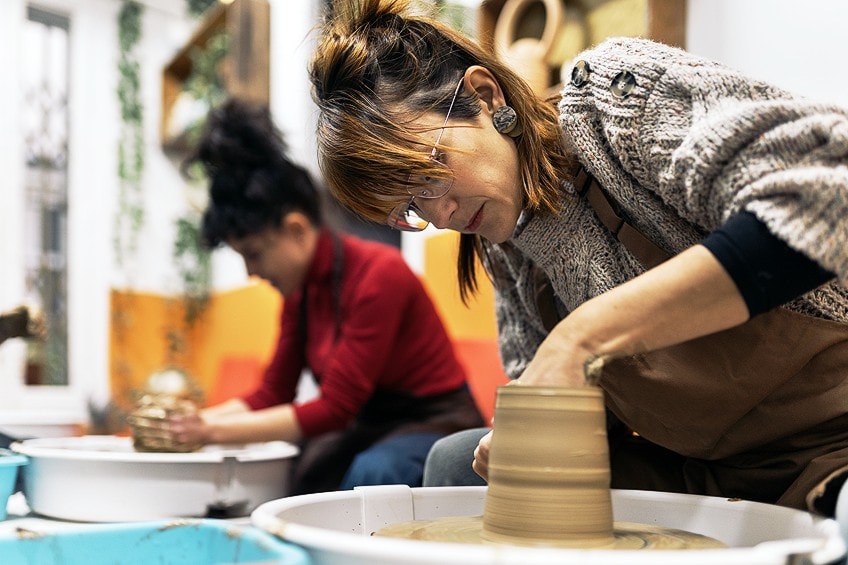Artist Residencies – What Is an Artist Residency Program?
Artistic residency programs or artist residencies are an excellent option for artists to make work with the financial, material, or curatorial support of an art institution. Applying for emerging artist residencies can be a wonderful way for young artists to explore their art styles and establish their careers. Artist residencies can also afford established artists an opportunity to create fresh work that is affiliated with well-known art institutes. In this article, we will ask the question, what is an artist residency, to understand how to apply, how artist residencies are funded, and when it makes sense to apply for an artist residency. We will also list a few good artist residencies in the U.S.
Table of Contents
What Is an Artist Residency?
How does the artist residency system work exactly? This is a common question, as most artists are interested in the opportunities that artist residencies offer. However, researching and applying for the residencies that suit your style, career, and intention can be hard work.
Artists’ residencies are programs, funded or partially funded, that afford artists time, materials, spaces, and briefs to explore outside of their everyday practices and lives.
Artist residencies are a time-specific artistic opportunity. When granted an artist residency, an artist would either move their practice to a specific space assigned by the residency institution for a set amount of time, work on a specific theme with a specific group of people, or create a body of work with the material, exhibition and curatorial support offered by the residency institution during a set timeline.

Many emerging artists try to launch their careers alone, but a residency program can help this process by giving the artist direction, funding, a studio, and exhibition opportunities.
How Are Artist Residencies Funded?
The funding of the artist residency depends on the institution. Some residency providers have funding from patrons, sponsors, or trust funds that allows them to financially support artists during the residencies they offer.
Whereas, other institutions require an application fee from applying artists which goes towards the funding of the residency.

How to Apply for an Artist Residency
Understanding how to apply for an artist residency requires a lot of reading. The process of application also involves a lot of work before you know whether you got the opportunity or not. Most residencies expect you to put together a lot of paperwork as part of your application, which can feel tedious and admin-heavy. However, going through this process is an excellent way to refine your supporting materials like your website, bio, artist statement, and portfolio. Let us look at what is generally required of you during the residency application process.
Research and Close Reading Is Key
Before you apply for artistic residency programs it is important to do your research. An open call is a message an organization that hosts residencies puts out. This document should include everything you need to know about the artist residency program.
It should clearly state how to apply for a specific artist residency with a specific company, how the artist residency is funded, and whether it is an emerging artist residency or an established artist residency.
These documents are often lengthy and the first filtering system of interested artists as it requires close reading. Artists often do not do this properly or do not feel like dedicating this time to close reading and, therefore, miss out on open calls relevant to their careers. If you do not read these texts carefully you might misunderstand what is required of you to apply, which could result in the rejection of your application.

Creating headings of all the requirements as you go through the open call will make your application construction more structured and correct.
In the open call, the theme will be explained. Artists are often expected to write a proposal illustrating how they will use their medium, concepts, and research to expand on this theme. These proposals also often have very specific requirements and it is important to understand what the residency institution wants from you from this selection, as well as what the word count limit is before you start writing.
Consider Time
Residency programs are all about time specifications. What sets it apart from being employed or represented by an art institute, is that residencies start and finish at specific times. These times are more often than not unnegotiable. You should make sure that you are available to work on the proposed work during the residency time. If you are applying for multiple opportunities make sure they do not overlap or clash in terms of dates.
If you have a full-time job, make sure you will be able to take leave if you are selected for a residency program.

In other words, you will not be able to necessarily earn a salary from artist residency opportunities and need to make sure you will be able to take time off to focus on the residency opportunity.
Consider Intention
Artist residencies are marvelous ways to launch your career, but only if it is aligned with your practice. You should make sure that the values and audience of the artistic residency program are aligned with your artistic intentions.
It does not make sense to apply for a sculpting residency if you are a printmaker, or to apply for a residency on an environmentally conscious project if your main medium is purchased, non-recyclable plastic.

However, we suggest choosing open calls that build on, expand, or draw from the work you do already.
Consider Funding
Read the open call carefully to understand what resources artistic residency programs give artists. Some programs might offer artists travel expenses and studio costs but expect the artist to pay for their accommodation. Others might cover all the costs but take full ownership of the created work. Some residencies are online and will require you to meet regularly to discuss your project. This might be a lot of work with no financial compensation.
However, we suggest choosing open calls that build on, expand, or draw from the work you do already.
Some artists apply for self-funded residency programs but search for mobility grants to cover their travel expenses. Mobility grants are often funded by independent art institutions that want to allow artists to travel for work. If you want to opt for this, you will need to make sure that there is enough time between the residency recipient announcement and the mobility grant allocation.

Artist residencies often take place annually or bi-annually, so sign up for the institution’s newsletter, prepare your supporting materials and apply the next year.
Consider Qualification
Emerging artist residencies often have an age limit or exhibition limit on qualifying artists. This means, that if you have had, for example, multiple solo shows, have practiced art for more than 10 years, or have gotten recognition in the art world you should not apply for emerging artist residencies. Other artist residencies clearly state that they only work with established artists.
Read these requirements carefully and be honest on your application.
You will probably meet the individuals that selected you to be part of the residency and work with them closely throughout the residency. If you have lied or made your achievements sound more impressive on your application, they will notice and this might affect your artistic integrity.

This way, all the artistic achievements on your resume will build on each other and make you a highly qualified artist.
Consider Resources
If your practice depends on specific resources, like being close to the ocean to collect ocean waste or a darkroom to hand-develop your prints, make sure the artist residencies you are applying for will be able to offer these resources to you. You will be away from your studio for a set amount of time and will have to work from a new and completely different studio. It is, therefore, important to consider how you can adapt your practice for travel and new spaces. If your process is very tedious, you should consider the intention with which you are entering the residency.
Artist residencies are often about meeting, networking, and collaborating with other artistic professionals.

Also, remember to keep an open mind about what you want to create during the residency.
Even though you might have to submit an in-depth proposal, you can not imagine how the new space and interactions with the other attendants will influence you. Allow yourself to be flexible and create artworks that truly reflect your experience in the new space.
The Application Process
Most artist residencies require you to submit a bio, resume, portfolio, or website. These supporting materials are important for all artists to get ready, whether you are actively applying for artist residencies or not (see our articles on artist bio and artist resume). You should tailor these supporting materials to the specific artist residencies you are applying for. If you work in performance art and painting, for example, but you are applying for a painting residency, emphasize your painting achievements in your bio and resume.
Most residency programs will ask you to write a proposal for the project you want to do during the residency.
They will often expect you to respond in this proposal to the residency theme, but not necessarily. In your proposal, you should dedicate a section to the conceptual reasoning behind your work. This is where you make the connection to the residency theme and expand on how your art will explore the specific concept by, for example, subject matter, symbolism, and metaphorical exploration.

A very important part of a residency proposal is the planning materials that accompany your text. These should illustrate your proposal to give the judging panel a visual idea of what your project would look like.
You can do a few planning sketches, collages, and mood boards, or illustrate what you want to do visually. Some artist residencies require you to include a timeline and budget in your proposal. Research how other artists have done these and keep the funding amount they offer in mind when setting up the budget. You want to give yourself as many resources and as much time flexibility as possible, so think carefully before submitting these documents.
What to Do When You Get Accepted
Thank the institution for accepting you and express your excitement about working with them. Do not email the institution with every question or problem you have. You need to keep your relationship with them professional and should be satisfied with the details they gave you in the open call and acceptance message. Only contact them if you are absolutely unsure about what is expected from you.
Research the country and people you will visit. It is important to be prepared for the journey, cultural changes, and institute you will visit.
This way, you will save time while you are there. If you research where to find food, bus cards, ATMs, and so on before you go, you will settle in easily and be able to focus on your work. Most residency programs have a support team on board that assists artists in getting comfortable when they arrive. Prepare everything you will need for the residency and travel. If you are planning on taking materials with you, make sure you are allowed to take them on the airplane or train you will be traveling with. It is better to arrive with everything you need than to arrive and have to spend precious time gathering materials.

Get everything in order in your studio before you leave. If there are orders that need to go out, projects that need to be finished, and admin to get done before you go, make sure that it is finished before you have to start your residency.
The idea behind an artist residency is to have focused time to finish, start or work on a particular project. Do not commit to anything else during the residency time. This could compromise your focus and you owe the institute and other artists that did not get the opportunity to make the most of it. Do not start the art you are meant to create during the residency the moment you are accepted. You can continue your research and planning, but the idea with artist residencies is that you should create the work in the specific location and within the time frame created for it.
Artist Residencies in the U.S.
The best way to go about finding artist residencies in the US is to simply research as much as possible. When you come across a platform or institution you like, join their newsletter to stay updated with residency open calls. Resartis is a great platform to join to receive the open calls for international residencies. Here follows a list of a few US-based residencies:
- The Chinati Foundation in Marfa, Texas
- The Whitney Museum of American Art Independent Study Program (ISP), New York, NY
- The MacDowell Colony in Peterborough, New Hampshire
- National Parks Art Foundation at multiple National Parks
- Ox-Bow Fall Artists and Writers Residency, Saugatuck, Michigan
- The Bemis Center for Contemporary Arts, Omaha, Nebraska
Artist residencies are exciting opportunities for artists that need a fresh perspective, dedicated time, and a kick-start to their careers. Even though applying is a lot of work, all the research and effort can help you define your supporting materials and proposal writing. It is always a better idea to try and get a rejection letter, than not to try at all. Stay positive and who knows, maybe your career-launching opportunity is around the corner.

Frequently Asked Questions
When Does It Make Sense to Apply for an Artist Residency?
If you have time, an idea, and need a break from your studio it is a good idea to apply for an artist residency. If you are looking for focused time to develop a project or want to launch your art career through a specific institution, applying for artist residencies is also a good idea. The application and participation requirements of each residency should give you an indication if you are a good fit for it or not.
Do All Artist Residencies Give Financial Support?
How are artist residencies funded? This is possibly the most common concern applying artists have. Unfortunately, not all residencies offer financial support. Some might be partially funded, by offering artists traveling costs, material costs, a daily stipend, studio space, or accommodation costs. However, some residencies are completely self-funded and simply offer artists the merit of being selected, exposure, exhibition opportunity, or networking opportunities.
How Do I Qualify for Artist Residencies?
Each residency open call has its own requirements for qualification. Some are emerging artist residencies and others are artistic residency programs for established artists. You need to study the open call you want to apply for carefully to make sure you fit the criteria.
Nicolene Burger is a South African multi-media artist, working primarily in oil paint and performance art. She received her BA (Visual Arts) from Stellenbosch University in 2017. In 2018, Burger showed in Masan, South Korea as part of the Rhizome Artist Residency. She was selected to take part in the 2019 ICA Live Art Workshop, receiving training from art experts all around the world. In 2019 Burger opened her first solo exhibition of paintings titled, Painted Mantras, at GUS Gallery and facilitated a group collaboration project titled, Take Flight, selected to be part of Infecting the City Live Art Festival. At the moment, Nicolene is completing a practice-based master’s degree in Theatre and Performance at the University of Cape Town.
In 2020, Nicolene created a series of ZOOM performances with Lumkile Mzayiya called, Evoked?. These performances led her to create exclusive performances from her home in 2021 to accommodate the mid-pandemic audience. She also started focusing more on the sustainability of creative practices in the last 3 years and now offers creative coaching sessions to artists of all kinds. By sharing what she has learned from a 10-year practice, Burger hopes to relay more directly the sense of vulnerability with which she makes art and the core belief to her practice: Art is an immensely important and powerful bridge of communication that can offer understanding, healing and connection.
Nicolene writes our blog posts on art history with an emphasis on renowned artists and contemporary art. She also writes in the field of art industry. Her extensive artistic background and her studies in Fine and Studio Arts contribute to her expertise in the field.
Learn more about Nicolene Burger and the Art in Context Team.
Cite this Article
Nicolene, Burger, “Artist Residencies – What Is an Artist Residency Program?.” Art in Context. October 6, 2022. URL: https://artincontext.org/artist-residencies/











